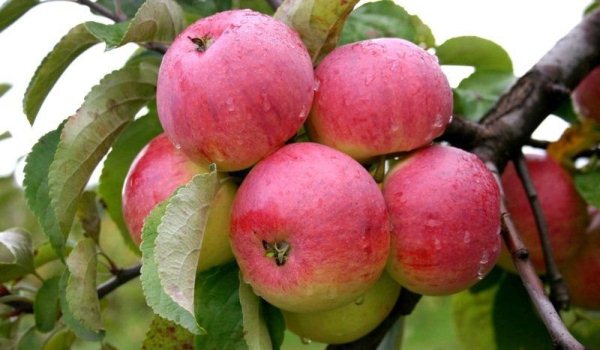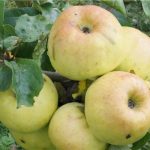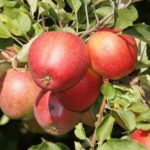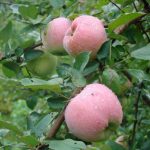Variety apple "Borovinka" - one of the old varieties. Many gardeners have chosen it for planting on sites thanks to the positive qualities:
- Unpretentiousness.
- Early fruiting.
- High yield.
- Resistance to frosts and diseases.
Table of contents
Characteristic varieties Borovinka
From the history
Borovinka was first described by A. T. Bolotov in the early 19th century. and more than 150 years ago, scientist M. V. Rytov wrote that apples of this variety are tasteless and equate them with the variety Antonovka.At the same time, the North Americans liked the variety and they began to grow it in their gardens, where it was named Oldenburg.
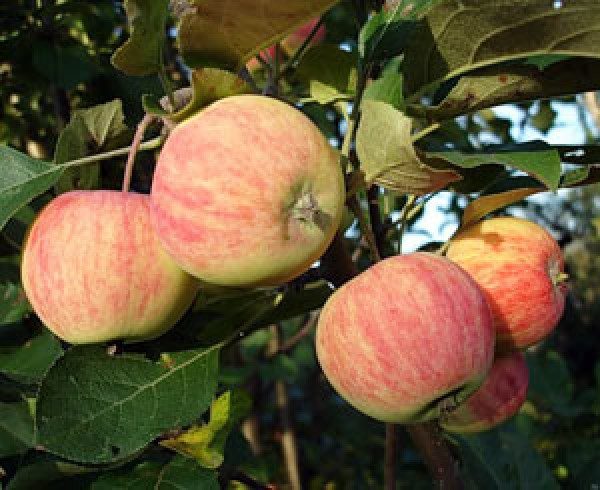
Western Europeans also began to grow Borovinka. The apple tree has spread throughout the regions of Russia. In different places it was called differently. She was called:
- Kharlamovka.
- Pouring Kharlamov.
- Borovitsky.
- Bravina.
For all time existence of a variety, the origin has not been established. Nowadays it is considered that this variety appeared as a result of popular selection.. On the basis of Borovinka breeders bred more than two dozen varieties.
Characteristics of trees and fruits
Variety Borovinka growers grown in many Russian regions. The apple tree is tall and grows to 4.5 m. A sparse crown with a diameter of 5.5 m is oval in shape. Smooth, green branches have a brown tint.. Wide, rounded leaves with gloss, dark green color are located at an angle of 90 degrees to the shoot.
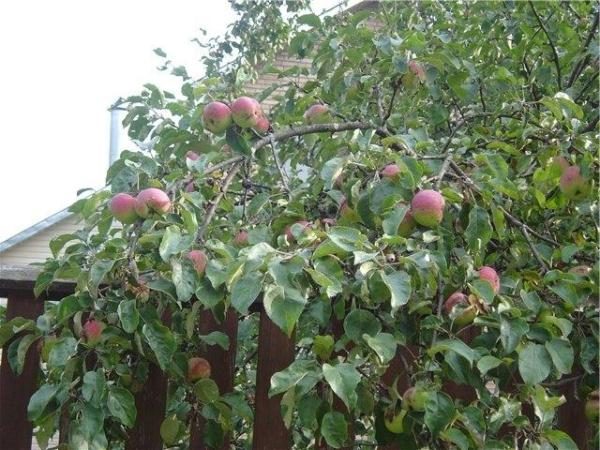
Apple trees of this variety with thin, long stalks of dark crimson hue. This variety is always early and abundant flowering. White inflorescences with a slight pink shade of medium size.
The apples grow from 90 to 200 grams. Correct, rounded shape. The color of the apple is green, of a light shade, but usually light yellow on the sides are red stains. The skin on the apples is smooth, with a slight waxy coating. Juicy, dense pulp. Sweet and sour taste. Used fresh, as well as jam, compote, dried. Produce juices. Cooked apples are cooked.
Advantages and disadvantages
Many gardeners have chosen this variety, but what is it good for?
- Early ripe variety.
- Can grow in any conditions.
- Does not need special leaving.
- Abundant the harvest.
- Frost resistant.
- The fruits are good in fresh and processed form.
- High resistance to pests and diseases.
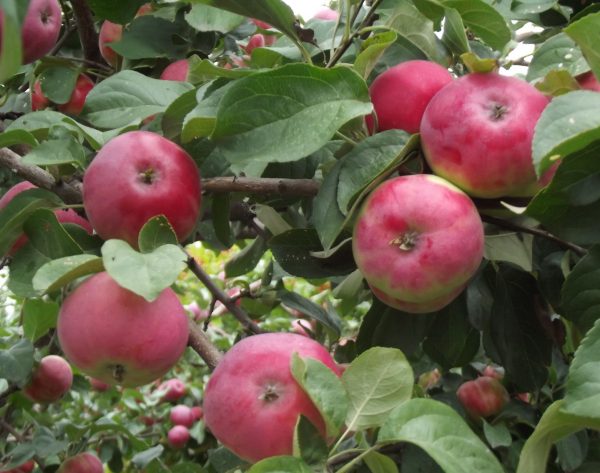
Disadvantages:
- Fruits with mild flavor.
- Bad growing in the heat and drought.
- Ripe apples fall from the tree.
- Fragile branches.
According to the positive characteristics it is clear that Boletum can be grown in any garden without much effort. For plants, watering during drought is important.
Types of apples of this variety
On the basis of the Borovinka variety, many species are bred. These include:
- Pineapple pineapple. A variety of late ripening. Apples are juicy. Pleasant sweet-sour taste. Apples from 80 to 120 grams. You can save until March. Not prone to scab.
- Orange. Late maturity The apples grow to 150 grams. Persist until June. Resistance to freezing. Not sick scab.
- Pink superb. Early ripe. Apples weighing up to 150 grams with a bright blush. Small shelf life - 10 days. Sick fruit rot and scab.
- Borovinka Sergeeva. Summer variety. Ripening at the end of summer. Fruits up to 150 grams. Up to ten days are saved. Apple tree hardy and high-yielding.
- Borovinka red. Medium ripening. Juicy apples. Saturated red color and sweet-sour taste. Weight is 100 grams. The tree is frost-resistant. Not subject to disease.
- Borovinka Akulovskaya. Medium ripening. Apples weighing 90 grams. Have green color of a light shade with a small flush. Stored until spring. Severe winters can freeze slightly, but quickly restore the crown. Should be treated with powdery mildew.
- Borovinka Akulovskaya
- Pineapple pineapple
- Borovinka red
- Pink superb
Apple trees begin to bear fruit from 4 years of age. Stable and high yields. With a 20 year old tree, more than 100 kg of apples can be harvested. In the southern regions they ripen at the end of the summer. In other regions, fruit ripening occurs in September.
Since the variety is self-infertile, planting pollinator varieties is required. For Borovinka fit these varieties:
- Papirovka.
- Astrakhan red.
- Anise.
- Antonovka.
- Cinnamon striped.
- Astrakhan white.
Planting and care
It is possible to grow Borovinka from seeds, but no one can predict the taste and size of the fruit. But lovers of experiments can grow Borovinka seedlings from seed. Such seedlings can later be used as a stock. These seedlings are grafted with varietal plants from which excellent yields are obtained.
It is best to buy seedlings in special nurseries, where they are engaged in growing seedlings. Biennial plants bear fruit much faster than seedlings of a different age.

When buying, pay attention to the condition of the plant. If the root system is open, then it should have a good lobe. Roots should not be dried or rotten. The elevated part must also have a healthy appearance. Those plants that are bought with closed roots can be planted at any time, but apple trees with an open root system need to be planted directly into the soil or put into the water before planting.
For apple trees to grow well, they need loamy or chernozem soil.. It is better if the groundwater will be more than 1.5 m deep. The earth should be light and pass moisture and air.
Use the following tool for landing:
- Shovel.
- As a level, take twine and stakes as it.
- Small pebbles or crushed stone as drainage.
- Garters need pegs.
Also for planting need fertilizer.
Apple trees better planted in the fall. Planted at this time the plants take root better. Pit cook a month before planting. Landing is also possible in the spring, but then the wells for planting should be prepared in the fall.
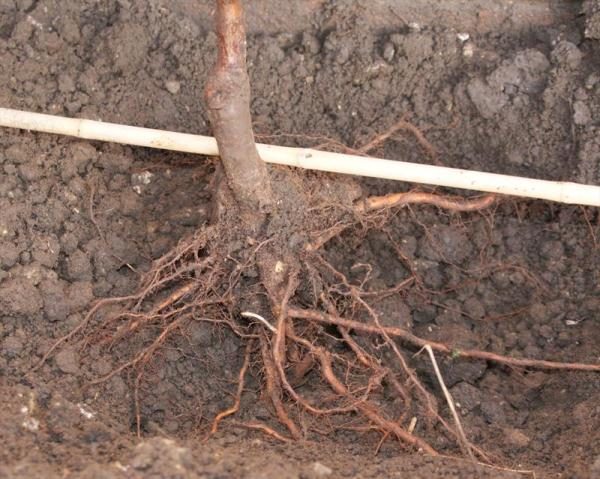
Dig a hole 60 cm deep and 1 m in diameter in the selected area. Pour 10-15 cm of drainage to the bottom. Fertilizer mixed with soil. At 1 pit should be made:
- Manure 5-7 kg.
- Peat 8-10 kg.
- Superphosphate 80-100 grams.
- Potassium sulphate 30-40 grams.
- Wood ash 1 kg.
In the center of the pit, drive a peg and attach a seedling to it.
It is more convenient to plant the plants together. One holds an apple tree, the other falls asleep. The soil should completely fill all voids, so from time to time shake the tree.
After the hole is filled with earth, it must be trampled.. After, fill in another layer of soil. Now tie the tree to the peg. This must be done so that the fragile plant will not be broken by the wind.
After planting, the apple tree should be watered abundantly. It is better to water in several stages so that the soil is thoroughly saturated with moisture.. First, carefully pour one bucket of water and then at intervals of two more.
Care for apple trees is small. In the heat, with a lack of moisture, they usually dump apples. Therefore, abundant watering is necessary in a hot, dry period. In a week, water 4-5 times.
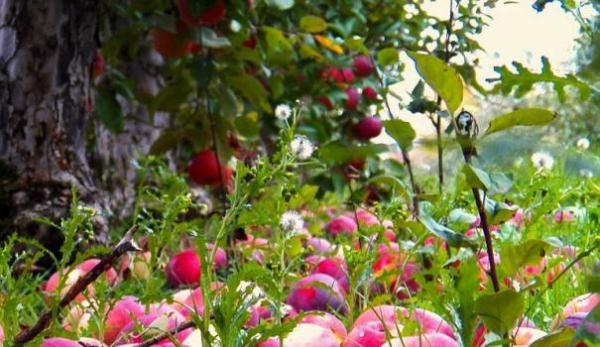
After irrigation or rain in pristvolnyh circles need to grouch the ground. This will increase air access to the root system of the apple tree. After loosening, pour a layer of mulch from peat or humus.This will prevent unnecessary work to remove weeds and drying out the soil.
With the onset of autumn, trees treat garden pitch and whitewash trunks. Dig the pristol circles, and add 20-30 kg of humus or compost for digging. In order to protect the tree from frost, the trunk is wrapped with roofing sheets, branches or covering material.
Prevention of diseases and pests
Variety Borovinka, practically not susceptible to diseases and attacks of pests, but prevention is still necessary. To do this, before the buds swell on the apple, should be treated with copper sulphate. 200 grams of vitriol are diluted with 10 liters of water. This solution is treated with apple. Until the buds blossom, process the trees with the Bordeaux mixture. It should be 3-4%.
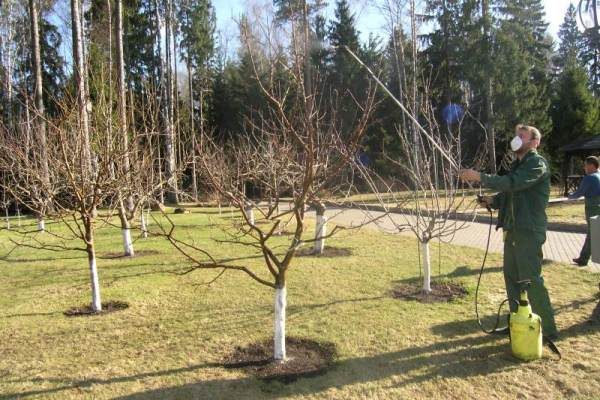
In early spring, it is recommended to trim the crown and clean the tree trunks from the dried bark.. At the same time, remove all frozen and broken branches. This procedure should be repeated in two weeks.
For prevention, you can use drugs such as "Topaz", which is diluted with 2 ml per 10 liters of water or "Skor". From apple scab fungicides help well.
When the apple tree blossoms, spray it with “Malophos”. For 10 liters of water take 80 grams of funds. Thoroughly mix and process the trees from insects.
Borovinka apples are stored until January-February. To preserve the fruits until spring, the apples are folded in capacity in rows. Put them stalk up and pour in sawdust. Storage temperature should be within + - 1 degree. Humidity should be kept 90-95%. Rows with apples sprinkle with sawdust or wrap each apple into paper.
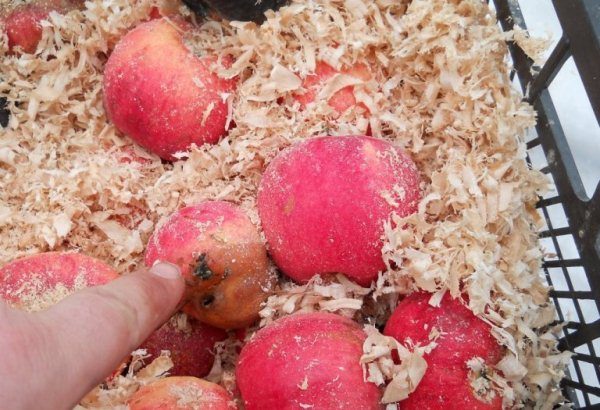
Gardeners, Borovinka variety attracted for yield and unpretentiousness. He is able to adapt to different environmental conditions. Therefore, this variety is widespread in gardens around the world. If you take into account the characteristics of the variety and follow the rules of care, then Borovinka will bring great harvests annually.
Reviews
Valery: I planted winter Borovinka on my plot. No time to ripen.
Alexander: Borovinka summer brings quite a lot of fruit, but you need to put props, otherwise the branches under the weight just break off.
Olga: Not very tasty apples, but the variety is fruitful. In the autumn, you can make a jam and compotes.
